
CHINA, 1997, Scott 2814
The Architecture of Jesuits |
Besides Brother Andrea Pozzo, and Brother Giuseppe Castiglione, mentioned elsewhere, there are many other Jesuit architects:
Blessed
Carlo Spinola, SJ
(1564-1622)

CHINA, 1997, Scott 2814
Blessed Carlo Spinola is usually thought of in regard to his sanctity and his martyrdom in Japan, but he also had architectural talents and planned the facade of St. Paul's, a signature piece of the Macao landscape. There are many stamps that feature this facade and they may be seen under Macao in Part II.
Brother
Luca Bienni, SJ
(1572-1613)

VATICAN CITY, 1991, the 4th centenary of the death of St.
Aloysius Gonzaga, aerogramme #29
The stamp of this aerogramme features the Basilica Sanctuary of Saint Aloysius Gonzaga in Castiglione delle Stiviere. This Baroque-style church was begun in 1608 and designed by a Jesuit from Lake Garda, Luca Bienni. Bienni was born in Salò, the capital of the Upper Garda area in the province of Brescia. He took his inspiration for this sanctuary from Barozzi da Vignola's plans for the Church of the Gesu in Rome. The presbyterium and cupola is the work of Paolo Soratini, the frescoes by Giorgio Anselm, the main altar by Antonio Balestra, and in a side chapel Our Lady of Sorrows by Guercino.
Brother
Pieter Huyssens, SJ
(1577-1637)

BELGIUM, 1975, Scott 927
The Church of St. Loup in Namur was built from 1621 to 1645 according to plans of Jesuit Brother Pieter Huyssens. It shows some features of the Roman School, such as the flat facade with superimposed orders, a touch of marble and the Baroque decoration of the period. Among Huyssens' other buildings are the Church of St. Charles Borromeo in Antwerp (1615-23), the design being also partly attributed to Peter Paul Rubens; St. Walburgha's Church in Bruges (1619-1642); and St. Peter's Abbey Church in Ghent, begun in 1629.
Brother
Jean du Blocq, SJ
(1583-1656)

FRANCE, 2004, Scott 2985b
A number of stamps feature the Cathedral of Luxembourg. The architect who designed the original church was the Jesuit brother Jean du Blocq. The work began in 1613, and the Jesuits remained at the church until the Suppression in 1773, when it became a parish church. Du Blocq also designed the Church of Saint Martin in Cateau Cambrésis (1634) and the college chapel of Saint-Omer (1615-1640).
Brother Giacomo Briano, SJ
(1589-1649)
FIUME, 1923, Scott 178In the city of Rijeka, Croatia (once Fiume) the present Cathedral of St. Vitus was founded in 1638 by the Jesuits and is pictured on this stamp in the hands of St. Vitus, its patron. The Church was designed by Br. Giacomo Briano da Modena, SJ (1589-1649), the Society’s architect in Poland and in Northern Italy. Briano was a northern Italian who was responsible for the magnificent Jesuit churches in Lemberger (L'viv) and Przemysl, among others. John Bury has published Forty-Three Sheets of Architectural Drawings by Giacomo Briano da Modena, SJ, (Milan: Radaeli, 1984).
Two of the major architects of the Buenos Aires area were Brother Giovanni Battista Primoli, an Italian Jesuit brother from Milan, and Brother Andrés Bianchi.
Br. Primoli is credited for designing the church of São Miguel, the church of Concepcion, the church of the Trinidad Reduction (along with Fr. Jose Grimau, SJ) and the Reduction of St. Ignatius Mini.
Br. Bianchi is credited for designing the Basilica of Saint Francis and the Chapel of Saint Roque, the Monastery of Catherine of Siena, the church at the Estancia Jesús María.
The two of them collaborated on the Church of St. Ignatius, the Basilica of Our Lady of Pilar and its attached monastery, the Church of Saint Peter González Telmo, the parish church of Our Lady of Mercy in Alta Gracia, the City Hall or Cabildo of Buenos Aires (below), and the cathedrals of Buenos Aires and of Cordoba (below).
THE CITY HALL OF BUENOS AIRES
ARGENTINA, 1980, the 4th centenary of Buenos Aires, Scott 1271
This 14 stamp se-tenant block shows a ceramic mural by Rudolfo Franco featuring the city hall
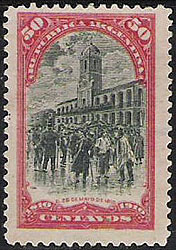
ARGENTINA, 1910, the centenary of the First Republican Government on 25 May 1810, Scott 171;
a small number of inverts of this stamp exist, Scott 171a

SPAIN, 1974, Scott 1841
NORTH KOREA, 1985, the Argentina '85 Exhibition, Scott 2589

ARGENTINA, 1977 and 1979, Scott 1164-65




URUGUAY, 1960, the 150th anniversary of the 1810 revolution, Scott 658-59, C208-10This is the 25 May 1810 revolution in which the Spanish rule over the area of the Viceroyalty of the Río de la Plata (now Argentina, Paraguay, and Uruguay) began to be overthrown. It was from the city hall in Buenos Aires that independence was proclaimed.
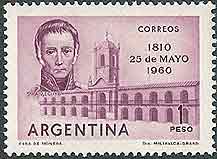




ARGENTINA, 1960, the 150th anniversary of the 1810 revolution, Scott 713-16, C75-C76


ARGENTINA, 1960, the 150th anniversary of the 1810
revolution, Scott C75a, C76a
ARGENTINA, 2010, above is the first third of a 19-inch booklet strip showing Miguel Rep's Bicentennial Mural celebrating 200 years of Argentine history, with Primoli's city hall in the first of 12 stamps (2572)
ARGENTINA, 2016 this special bicentennial min sheet also displays Primoli's cabildo.

ARGENTINA, 1961, the 1962 International Stamp Exhibition, Scott B37a
The cathedral of Cordoba is to the left, that of Buenos Aires to the right.


ARGENTINA, 1961, the Cordoba cathedral, Scott B35
1970, the Cordoba cathedral, Scott 945
special cancel for the visit of Pope John Paul II in 1987


ARGENTINA, 1934, The Buenos Aires cathedral, Scott 415
1961, the International Stamp Exhibition, Scott B37
ARGENTINA, 1980, postal card of the Buenos Aires cathedral
based on an oil painting by Carlos Enrique Pellegrini

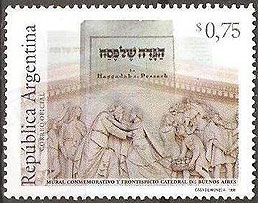
ARGENTINA, 1989, Holy Week, with the Buenos Aires cathedral, Scott 1643
ARGENTINA, 1995, the new facade of the Buenos Aires cathedral
Joseph Meeting his Father and Brothers sculpted in 1860-63 by Joseph Dubourdieu,
and a special cancel for the visit of Pope John Paul II in 1987Father Tomas Žebrauskas, SJ
(1714–1758)
LITHUANIA, 2005, the Jesuit Church of St. Casimir in Vilnius, Scott 797Jesuits began construction of this church in 1604; it was finished and consecrated in 1635. But it burned down in 1655 and again in 1707 and 1749. The Jesuit architect and astronomer Tomas Žebrauskas headed the reconstruction of the church in 1749-55. His work can be seen in the graded cupola and the main altar.
Brother Eulalio Morales, SJ
(1837-1907)
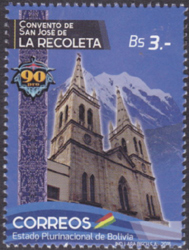
BOLIVA, 2015 the church of La Recoleta designed by Br. Morales, SJThe church of La Recoleta, featured as part of the Cultural Heritage of Humanity, is one of the most important works of the master architect Jesuit brother Eulalio Morales, the creator of many and important buildings at the end of the nineteenth century, so that he has been called the father of the neo-Gothic Paceño style.
Father Ignatius Scoles, SJ
(1839-1896)


GUYANA, 1969 Scott 103, 105
The town hall of Georgetown, the capital and chief port of Guyana, stands on the corner of the Avenue of the Republic and Regent Street. This building, inspired by the Gothic revival then current in England, was designed by Fr. Ignatius Scoles, SJ, who won $50 for the winning design. The foundation stone was laid on December 23, 1887, and the building opened on July 1, 1889. Scoles also designed the tower of St. Mary's Chapel, which was destroyed in 1913 and replaced by the present cathedral.
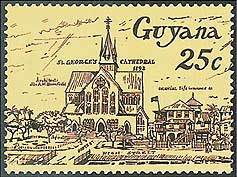

GUYANA, 1985, a series on Georgetown architecture, Scott 918, 921
Father
Alphonse Taix, SJ
(1835-1862)


MADAGASCAR, 1967, Catholic cathedral of Tananarive, Scott 397
MADAGASCAR, 1968, Catholic cathedral of Fianarantsoa, Scott 415
The first Jesuits in modern times to come to Madagascar, arrived from the French Province of Lyon in disguise in 1855, being unable to come openly as priests. Queen Ranavalona I ordered the expulsion of Europeans, but the Jesuits in the meanwhile had made friends with her son, Radama II. When he succeeded his mother in 1861, the Jesuits and Catholic missionaries were welcomed back to Tananarive.
Fr. Alfonso Taix, SJ, who was born in Bédarieux (Hérault) France in 1835, came as a missionary to Madagascar in 1862. He did pastoral ministry in Antananarivo, where died in 1921. He was an active founder and animator of rural parishes in the eastern part of the country.
In 1873 Prime Minister Rainilaiarivony gave the Catholic mission the land on which the Tananarivo cathedral is now built. Three sets of plans were considered, but the ones chosen were those of the Jesuit father Alphonse Taix. The cornerstone was laid that year, the cathedral was completed 17 years later and consecrated in 1890. Three years later the cathedral of Fianarantsoa (1893) was also built according to his plans.
Since then the name of the capital has been changed to Antananarivo. The Tananarivo Cathedral of the Immaculate Conception, is usually referred to as the Catholic cathedral of Andohalo, the area of the city in which it is located.
Brother
Polydor Verbrugge, SJ
(1870 -1949)

SRI LANKA, 2003, the centenary of the founding
of the Congregation of the Sisters of the Holy Angels, Scott 1442
The congregation was founded by Jesuit Bishop Joseph Van Reeth. The building on the right, the first convent of the sisters, was built by Jesuit Brother Polydor Verbrugge.
Brother
Theofiel Roelandt, SJ
(1872-1942)


SRI LANKA, 2007, the centenary of the Shrine of Our Lady of Matara, Scott
1607
SRI LANKA, 2008, the centenary of St. Mary's Convent, Scott 1647
When Bishop Joseph Van Reeth, SJ was appointed Bishop of Galle in Ceylon in 1895, before he left Belgium for his new see, he asked the Sisters of Charity of Jesus and Mary, of which his sister was a member and would become mother superior, to come to his diocese. Their first establishment was a school and orphanage in Galle, their next was in Matara. The church in Matara, now known as the Shrine of Our Lady of Matara, was formally dedicated on August 4, 1907, and celebrated its centennial in 2007. St. Mary's Convent next to it was completed in the following year. Brother Theofiel Roelandt, SJ was responsible for both structures. He was born July 10, 1872 in Kalken, Belgium, about 8 miles east of Ghent, and died November 07, 1942 in Drongen. He entered the Jesuits May 8, 1895, was assigned to the Ceylon mission, and worked at Matara until 1920.